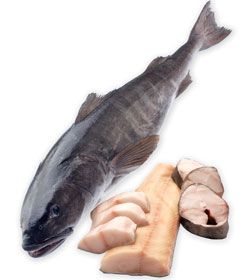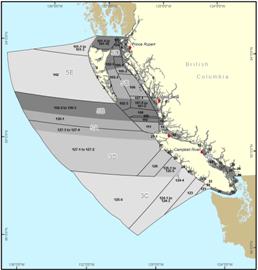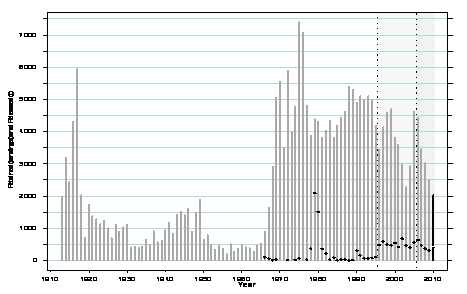Sablefish

- Name:
- Sablefish
- Latin Name:
- Anoplopoma fimbria
- Group Name:
- Groundfish
- Location:
- Pacific Ocean
- Fishing Gear:
- Primarily longline hook and trap gear, some trawl gear
- Season:
- Year-round
Species at a Glance
Sablefish are one of the most valuable species on Canada’s west coast. This deep-sea fish is found in the Pacific Ocean as far north as the Bering Sea, and as far south as Japan and California. Sablefish live on shelf and slope waters at depths of about 1,500 meters.
More than 74 per cent of Canada’s sablefish are exported to Japan. Other key markets include the United States and the United Kingdom.
- Landings:
- Canadian landings were 1,951 tonnes in 2013, 2,281 tonnes in 2012, 2,124 tonnes in 2011 and 2,412 tonnes in 2010.
- Value:
- Landed value was $16.3 million in 2013, $20.9 million in 2012, $19.2 million in 2011 and $21.8 million in 2010.
- Abundance status and trends:
- The spawning stock biomass is estimated to range from approximately 28,000 t to 57,000 t. Sablefish stock indices have shown a general decline between 2003 and 2012 as the 2000 year class decreases in abundance.
- Fisheries:
- Sablefish are caught commercially year round; primarily in deep coastal waters. The portion of the total allowable catch allocated to the commercial fishing quota (2,225 t for the 2012/2013 fishing seasons) is managed through an Individual Vessel Quota system.
- Conservation measures:
- Fish harvesters are accountable for their catch of sablefish with 100 per cent at-sea video or observer monitoring and dockside validation of landings. There are also gear restrictions to prevent “ghost fishing” and bycatch of seabirds or marine mammals, and area closures to prevent directed harvest of juvenile sablefish and to reduce fishing impacts on species at risk and sensitive habitats such as coral and sponge reefs.
Species Background
Sablefish can be highly migratory. Tagged fish show movement from the inside waters of Hecate Strait and mainland inlets to the offshore waters of British Columbia as far north as the Aleutian Islands and south to American waters off Oregon. The oldest fish recovered from British Columbian waters was aged at 92 years.
Age, growth rate and maturity of sablefish vary markedly among areas and depths. Initial growth is rapid, with mature females reaching an average fork length of 55 cm in 3-5 years. Large year-classes occur infrequently, with stock production characterized by periods of moderate to low recruitment.
Fisheries
The first recorded landings of sablefish date back to 1913. While initially caught as bycatch, Canada’s sablefish industry grew rapidly as a targeted fishery in the late 1970’s and early 1980’s. In 1981, the commercial sablefish fishery was limited to 48 licences and that number remains in effect today. In 1990, an Individual Vessel Quota system was introduced to allocate specific quotas to the licenced vessels based on their historical catch records. In conjunction with fishery-independent monitoring, the system also ensures that fishing does not exceed the total allowable catch.
The commercial sablefish harvest season begins February 21 and ends February 20 the following year. Allocations of the total allowable catch are made to First Nations, research, and commercial fisheries. A small percentage is also provided for aquaculture brood-stock collection.
Commercially, sablefish are caught coast-wide in directed fisheries by the longline trap and hook, and trawls. The trawl sector is allocated 8.75 per cent of the commercial total allowable catch. Sablefish are also caught by groundfish longline hook fisheries primarily directed at Pacific halibut, rockfishes, lingcod, and spiny dogfish; these fisheries are also fully monitored and must acquire quota to account for their catch of sablefish. Sablefish smaller than 55 cm fork length are released at sea by regulation.

Figure 1. Sablefish fishing areas
Figure 1 is captioned “Sablefish fishing areas”. It is a map of sablefish fishing areas off the coast of mainland British Columbia from the Canada-United States border to the north (with Alaska) and the south (with Washington), as well as off the coasts of Vancouver Island and the Haida Gwaii (Queen Charlotte) Islands. The latitudinal (46 to 54 degrees North) and longitudinal (136 to 124 degrees West) coordinates are featured along all sides of the map. The map shows both the Canadian and American land masses, as well as the Pacific Ocean. The boundaries of the sablefish fishing areas are outlined and all of the main areas are numbered: (from bottom to top) 3C, 3D, 5A, 5B, 5C, 5E, and 5D. All of the sub-areas are also numbered, while key communities (Campbell River, Port Hardy, Bella Bella, and Prince Rupert are situated on the map.
Sablefish Management
The Canadian Sablefish Association and Fisheries and Oceans Canada have engaged in annual collaborative agreements since the 1990’s to work jointly on assessment, management, and enforcement activities.
Conservation Measures
Fisheries and Oceans Canada works closely with the sablefish industry to develop the stock assessment and formulate the Sablefish Harvest Plan contained within the Groundfish Integrated Fisheries Management Plan.
Conservation measures include the collection of reliable stock and fishery monitoring data, development of assessment methodology, and application of a harvest decision rule consistent with Canada’s Fishery Decision-Making Framework Incorporating the Precautionary Approach to fisheries decision-making. The sablefish management procedure provides advice on harvest levels that meet specific conservation and stock growth objectives over the short- and long-terms.
A key management measure used to implement the harvest advice is the total allowable catch limit. This limit is implemented using an integrated program of mandatory logbooks, 100 per cent at-sea monitoring of catch, and dockside validation of all landings. This Commercial Groundfish Integration Program requires individual fishermen to be accountable for all sablefish caught in all ground fish fisheries. The groundfish industry is highly involved in establishing monitoring standards and recommending corrective measures when reporting falls below standards.
Other conservation measures include:
- limited entry ;
- legal size limit of 55 cm fork length to allow the majority of sablefish to reach sexual maturity and reproductive age before capture for all gear types;
- the requirement that traps have two escape holes (no smaller than 8.89 cm) to reduce retention of undersized and immature fish;
- the requirement that traps feature a biodegradable “rot” panel so that lost gear will not continue to catch fish (i.e., to avoid “ghost” fishing);
- a maximum soak time of four days for long-line gear to reduce wastage;
- a requirement to report lost gear;
- required use of seabird deterrent streamers to discourage seabirds from taking bait during gear deployment and retrieval for long-line hook gear;
- closure of British Columbia mainland inlets to directed sablefish commercial fishing to minimize fishing of juveniles; and
- compliance with area closures to protect sensitive benthic habitat containing corals and sponges, and other species (e.g., Rockfish Conservation Areas).
Landings
Since 1969, total annual landings have ranged from 2,290 t (2003) to 7,410 t (1975), with the average landings at about 4,740 t between 1969 and 1999. Landings declined to 2,350 t in 2010 when the total allowable catch was reduced.

Figure 2. Annual sablefish landings (vertical bars) and releases (circles) from 1913 to 20101
Figure 2 is captioned “Annual sablefish catches commercially retained from 1913 to 2010”. There is a footnote referenced from the caption to describe other parts of the table’s legend: vertical dotted lines represent the trawl at-sea observer period (1996 to 2006) and catch monitoring for all groundfish sectors in 2006; and the circle represents released catch totals. The y-axis of the chart is a measurement of both retained landings and released fish caught as bycatch. It is divided into increments of 500 tonnes starting at 0 and increasing to 7,500 (numbers are only featured by 1,000 t, e.g., 1,000, 2,000, 3,000, etc.). The x-axis lists the years of every decade from 1910 to 2010, while the bars showing landings and releases begin in the year 1913. The table shows historical catches of sablefish remaining relatively consistent between 1919 and 1968 (with very high catches recorded in 1914 and 1915 compared to surrounding years. Sablefish landings were once again very high in 1970 and 1972 (between 5,000 and 6,000 t, and this spiked to more than 7,000 t in 1975 and 1976. Following that time, sablefish landings were generally between 3,500 and 5,000 t, but have slowly decreased since 2007 to 3,000, 2,500, and 2,000 by 2010. Beginning in 1966, and annually thereafter, a circle shows the amount (in tonnes) of sablefish released. This total was highest in 1979 and 1980 at more than 2,000 t and 1,500 t, respectively. The total weight of sablefish released over the past decade has been around 500 t.
1 Vertical dotted lines indicate the introduction of trawl at-sea observers in 1996 and catch monitoring for all groundfish sectors beginning in 2006. The circles represent estimates of sablefish releases.
Population Estimates
Sablefish stock abundance and biological data are provided by a dedicated fishery-independent trap survey conducted collaboratively by Fisheries and Oceans and the Canadian Sablefish Association. These data are used each year to provide harvest advice, including the total allowable catch for the fishing year.
Estimates show that the spawning stock is presently below the fishable biomass at maximum sustained yield. Sablefish is currently estimated as being in the mid-Cautious zone to low-Healthy zone based on Canada’s Fishery Decision-Making Framework Incorporating the Precautionary Approach. In recent years, the harvest rate on the sablefish stock has been moderate. Consistent application of the existing management rules in the fishery should maintain a moderate harvest rate.
Additional Information
- Agriculture and Agri-Food Canada Trade Fact Sheet: Sablefish
- DFO aquatic species profile: Sablefish
- DFO Pacific Region: Integrated Fisheries Management Plan
- DFO: Canadian Science Advisory Report (Sablefish, 2011)
- DFO: Canadian Science Advisory Secretariat Research Document (Sablefish, 2011)
- DFO: Sustainable Fisheries Framework policies
- DFO: Canadian Commercial Fisheries Data (2011): Values and Quantities
- Marine Stewardship Council Canada sablefish certification
- Marine Stewardship Council Canada sablefish: Full Certification Report
- Date modified: